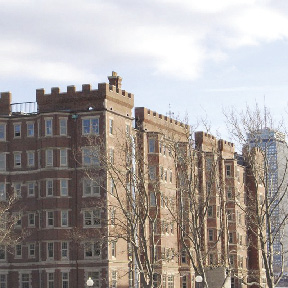J.&M. Brown Company, Inc. (JMB) recently completed comprehensive electrical construction for the MIT Building W1 renovation at 305 Memorial Dr. The complex multi-phase project entailed restoration of the historic structure, which is MIT's oldest student residence.
The restored Building W1 is a 6-story, 160,000 s/f residential building that houses a food servery and conference rooms on the first floor and residential suites for undergraduate students, RAs and housemasters on floors 2 through 7. The first floor has been restored to its original grandeur, circa 1901.
J.&M. Brown's scope included ground-up restoration of the building's electrical systems, including new primary and emergency power, energy efficient lighting and lighting control systems, and a new life safety/fire alarm system. JMB also provided conduit and wiring for the security system infrastructure as a subcontractor Siemens, the security system provider. In addition, JMB provided power and control wiring for the 16,000 s/f kitchen facility's specialized refrigeration systems.
Lutron LED lighting is installed in cove areas of the food servery and lighting control is provided via a Lutron Dimming Lighting Control system for the first floor conference center and dining rooms. Upper floors feature energy efficient fluorescent fixtures in dorm rooms and corridors.
For life safety, Building W1 is equipped with an advanced Simplex dual fire alarm system, which integrates separate smoke evacuation controls and alarms for all 362 dormitory residences. The life safety project was managed by JMB fire alarm division vice president Tom Rose.
In an aspect of the electrical construction project that has special significance and application for MIT graduate students, JMB installed an EMON DEMON electrical power monitoring system. The system is comprised of 100 monitoring system sub-panels, enabling MIT student residents to monitor the building's electrical usage. Each floor is divided into 5 or 6 sections and students have contests to determine which section in the building is most energy efficient.
The complex electrical project required JMB to incorporate numerous field changes to the renovated structure in order to retain the building's original design. As the brick and wood framed structure was demolished and reframed, significant changes to the structure's electrical layouts became necessary. In fact, of the 350 architectural changes that were required, 179 affected the building's electrical, lighting and power systems.
JMB's special projects group division manager and senior project manager Steve Cabral, general superintendent Paul Arthur, and general foreman John Mallett supervised the overall electrical project, managing an electrical field crew of 35 IBEW Local 103 electricians.
Due to project's complexity and the significant generation of electrical, mechanical and plumbing field changes, design-build contractor Shawmut Design & Construction maintained an onsite field staff of senior level management and engineering personnel to oversee the project. At peak construction, the Shawmut team managed more than 300 skilled workers in diverse trades.
From J.&M. Brown's perspective, management and coordination of equipment and personnel were critical to the project's success. Cabral commented on those challenges, saying, "Through careful planning, expedited delivery of electrical equipment from our vendors, and our skilled crew of IBEW 103 electricians, the J.&M. Brown team was able to effectively manage power and lighting installations, which included a new substation, emergency generator and backup generator, 104 electrical panels and more than 4,000 light fixtures, to meet the aggressive project schedule. Shawmut deserves great credit in facilitating work on the W1 project that was condensed to a nine-month schedule. They adeptly managed all work and workers in the historic restoration."
Work on the W1 restoration project commenced in Fall 2009 and was suspended shortly thereafter due to economic conditions. In September 2010, project construction began again, and the majority of project was handled in the ensuing nine-month period, through July 2011. The project was completed as scheduled, in August 2011, when MIT took occupancy for the start of the current academic year.
ESFI Launches 2012 National Electrical Safety Month Resources
The Electrical Safety Foundation International (ESFI) announces the availability of resources that electrical industry participants can use to promote electrical safety in their own communities during National Electrical Safety Month (NESM), which the organization sponsors each May. Among the emerging technologies and related safety issues to be highlighted this year during NESM are electric vehicles, solar power, wind power, and smart meters. The 2012 NESM materials are available on ESFI's website at www.electrical-safety.org.
ESFI is a non-profit organization dedicated exclusively to promoting electrical safety and engages in public education campaigns throughout the year to reduce electrically-related fires, fatalities, injuries, and property loss. As champions of electrical safety, NECA, the Boston Chapter, and our members, are proud to join in supporting ESFI's mission. NECA contributes to the foundation and is represented on the ESFI board of directors by our association's vice president and chief operating officer Dan Walter.
Excerpted from www.necanet.org
Tags:
NECA contractor J.&M. Brown Company Inc. completes electrical renovation of MIT's 160,000 s/f historic Building W1
April 19, 2012 - Construction Design & Engineering
.png)







